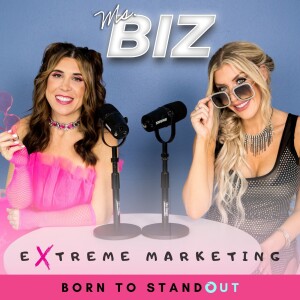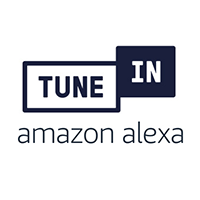Episodes

Tuesday Apr 30, 2024
Tuesday Apr 30, 2024
Episode 50 is about Billboards... One of the most common questions we get asked in the field of advertising is whether billboards are effective. As business owners who have utilized billboard ads ourselves, we thought we'd share our experiences and insights on this topic. When I first became interested in doing a billboard, I didn't know the first thing about how to go about it. Who do you contact? How much do they cost? I had so many questions. So today, we'll be answering some of the most frequently asked questions about billboards and diving deeper into the pros and cons.Some key points we cover include:- The billboard application and approval process - Typical billboard costs (anywhere from $500-$5,000 per month depending on size and location!)- Effectiveness metrics - do they actually generate sales? - Memorable billboard campaigns we've seen- Creative design tips that stand out- Pros like high visibility and brand awareness building- Cons like limited messaging and short exposure timesFrom my personal experience, I found billboards to be one of the best ways to increase name recognition and establish credibility as a new business. People would often come up to me to say they recognized me from my billboard. While billboards may not directly result in phone calls, they do familiarize potential customers with your business over time since most people see the same billboards daily. And in certain industries like personal injury law, billboards can be highly effective at informing people about your services when they may need them.
Join us as we explore Billboards and more!
Msbizpod.podbean.com
www.facebook.com/MsBizPodcast
www.BoltzLegal.com
www.BoltzMedia.com

Tuesday Apr 23, 2024
Tuesday Apr 23, 2024
Welcome back to Episode 49! We're jumping into the game-changing concept of the 80/20 Principle. Join us as we unpack this powerful strategy for maximizing productivity and results in your business. From identifying your most profitable activities to streamlining your workflow, we'll explore how applying the 80/20 Principle can revolutionize the way you work and propel your business forward. Whether you're a solopreneur, a startup founder, or a seasoned CEO, this episode is packed with practical insights and actionable tips to help you work smarter, not harder. Tune in to Ms. Biz Episode 49 and discover how to harness the power of the 80/20 Principle to unlock new levels of success in your business!
Msbizpod.podbean.com
www.facebook.com/MsBizPodcast
www.BoltzLegal.com
www.BoltzMedia.com

Tuesday Apr 16, 2024
Tuesday Apr 16, 2024
Episode 48: The power of storytelling: How effectively telling stories can help relate your brand and message to others. Stories are memorable when they evoke emotions, have relatable characters, connect the audience to shared values, and temporarily distract from daily life. When telling stories, it is important to have sensory details, a clear beginning-middle-end structure, and resolution.Rachel shares how she was motivated to succeed academically after twice failing to qualify for the gifted program as a child. This sparked a drive to prove doubters wrong and achieve at high levels. Brooke discusses facing skepticism when starting her law firm outside of her previous career, motivating her to succeed beyond expectations. They explain how overcoming challenges in life stories builds character and memorability.Effective stories include: stakes that are serious enough, identifiable characters, clear cause-and-effect between events, and relevance to the audience. Stories should be concise like a toast while hitting three key attributes and backing one with a short relevant anecdote. Superfluous details should be removed. Finally, stories must align with biblical values while maintaining pure intentions of encouragement rather than spite. Overall, storytelling is a powerful tool for businesses, speakers, and building relationships.
Msbizpod.podbean.com
www.facebook.com/MsBizPodcast
www.BoltzLegal.com
www.BoltzMedia.com

Tuesday Apr 09, 2024
Tuesday Apr 09, 2024
Welcome to Episode 47 of 'Ms. Biz,' the podcast dedicated to empowering women in business. In this episode, titled 'Crafting an Exceptional Customer Experience,' we dive into the crucial topic of fostering positive interactions with our clients. Join Brooke and Rachel as they uncover strategies, insights, and best practices for creating memorable and meaningful experiences for our customers. From personal anecdotes to actionable tips, we explore how businesses can go above and beyond to exceed customer expectations and build strong, loyal relationships. Whether you're a seasoned entrepreneur or just starting out, this episode is packed with invaluable advice to help you differentiate your brand and leave a lasting impression. Tune in to 'Ms. Biz' Episode 47 and discover how you can elevate your customer experience game to new heights!
Msbizpod.podbean.com
www.facebook.com/MsBizPodcast

Tuesday Apr 09, 2024
Tuesday Apr 09, 2024
Welcome to Episode 47 of Ms. Biz, the podcast dedicated to empowering women in business. In this episode, titled 'Crafting an Exceptional Customer Experience,' we dive into the crucial topic of fostering positive interactions with our clients. Join Brooke and Rachel as they uncover strategies, insights, and best practices for creating memorable and meaningful experiences for our customers. From personal anecdotes to actionable tips, we explore how businesses can go above and beyond to exceed customer expectations and build strong, loyal relationships. Whether you're a seasoned entrepreneur or just starting out, this episode is packed with invaluable advice to help you differentiate your brand and leave a lasting impression. Tune in to 'Ms. Biz' Episode 47 and discover how you can elevate your customer experience game to new heights!
Msbizpod.podbean.com
www.facebook.com/MsBizPodcast
www.BoltzLegal.com
www.BoltzMedia.com

Tuesday Apr 02, 2024
Tuesday Apr 02, 2024
Join us in Episode 46 where we interview S.B. The Anomoly, a two-time national karate champion and an accomplished youth, as he shares his legacy, challenges, aspirations, and his mantra of life.
In this video, SB delves deep into his past where at just 10 years old, he was a two-time national karate champion. Coming from the colorful Bronx, he was always admired the stylishly dressed comrades and heroes, which led to his now-iconic fashion sense.
Throughout his journey, SB faced numerous trials including bullying and injuries that ended his martial arts career. But, he didn't let these setbacks define his destiny. Instead, he found solace in freestyle rapping, a skill which later became his strength by enhancing his communication and boosting his confidence.
Apart from rapping and karate, SB is a maestro in teaching *diverse subjects* such as dance, martial arts, credit management, poetry, and public speaking. Fuelled by his unceasing desire to learn and make the most out of his talents, SB has an interesting take on managing time and avoiding the constant humdrum of work-related travel.
Next, SB is set to sway his audience with his upcoming projects that consist of an intense and emotional new song about his rigorous life journey, all set to be picturised through a heartfelt music video. Being a passionate philanthropist too, SB takes pride in mentoring the youth and participating in charitable deeds.
His never-give-up attitude coupled with his knack for converting trials into triumphs is what keeps him motivated to prove his skeptics wrong. SB's earnest advice to his followers includes reading the audience, finding common grounds to connect, stepping out of the comfort zone, and performing in front of the right crowd.
Don't forget to connect with SB on his social media channels or his website if you wish to hire him for events, workshops or performances, or if you simply need a dash of inspiration from his life-altering, powerful story of triumph.
Msbizpod.podbean.com
www.facebook.com/MsBizPodcast
www.BoltzLegal.com
www.BoltzMedia.com
S.B. The Anomoly is on X.com @SBTheAnomoly

Tuesday Apr 02, 2024
Tuesday Apr 02, 2024
Join us in Episode 46 where we interview S.B. The Anomoly, a two-time national karate champion and an accomplished youth, as he shares his legacy, challenges, aspirations, and his mantra of life.
In this video, SB delves deep into his past where at just 10 years old, he was a two-time national karate champion. Coming from the colorful Bronx, he was always admired the stylishly dressed comrades and heroes, which led to his now-iconic fashion sense.
Throughout his journey, SB faced numerous trials including bullying and injuries that ended his martial arts career. But, he didn't let these setbacks define his destiny. Instead, he found solace in _freestyle rapping_, a skill which later became his strength by enhancing his communication and boosting his confidence.
Apart from rapping and karate, SB is a maestro in teaching *diverse subjects* such as dance, martial arts, credit management, poetry, and public speaking. Fuelled by his unceasing desire to learn and make the most out of his talents, SB has an interesting take on managing time and avoiding the constant humdrum of work-related travel.
Next, SB is set to sway his audience with his upcoming projects that consist of an intense and emotional new song about his rigorous life journey, all set to be picturised through a heartfelt music video. Being a passionate philanthropist too, SB takes pride in mentoring the youth and participating in charitable deeds.
His never-give-up attitude coupled with his knack for converting trials into triumphs is what keeps him motivated to prove his skeptics wrong. SB's earnest advice to his followers includes reading the audience, finding common grounds to connect, stepping out of the comfort zone, and performing in front of the right crowd.
Don't forget to connect with SB on his social media channels or his website if you wish to hire him for events, workshops or performances, or if you simply need a dash of inspiration from his life-altering, powerful story of triumph.
Msbizpod.podbean.com
www.facebook.com/MsBizPodcast
www.BoltzLegal.com
www.BoltzMedia.com
S.B. The Anomoly is on X.com @SBTheAnomoly

Tuesday Mar 26, 2024
Tuesday Mar 26, 2024
Welcome to Episode 45 where we delve into the integration of _faith and biblical principles_ into everyday business practices. This discussion covers significant topics that mold how businesses operate, emphasizing aspects like integrity, treating employees fairly, _ethical decision-making, serving others, and _stewardship of resources.
Throughout this episode, we bring to life the essence of Proverbs 11:3 as we stress the importance of transparency and treating others as you want to be treated for business integrity. We believe in putting clients' needs first as integral part of being upright in business.When it comes to fair treatment of employees, we explore the need to ensure fair pay, growth opportunities, and creating a healthy work environment that echoes God's treatment of people. Our ethical decision-making segment advises on cultivating wisdom through praying, reading scripture, seeking advice from mentors, and trusting your peace, as highlighted in James 1:5. We also discuss the relevance of utilizing your business platform to serve others and support worthy causes, emphasizing the spirit of service outlined in Matthew 20:28.Colored by the wisdom of Luke 16:10, we share insights on the _stewardship of resources_. We express the importance of managing finances wisely and ethically through donating, giving and avoiding overspending.Lastly, we invite all listeners to share how they have integrated biblical principles into their business, whether it's through emphasizing core values or inserting these principles into business plans. Our goal is to ignite a mutual learning experience about how to apply faith in our business lives.
Msbizpod.podbean.com
www.facebook.com/MsBizPodcast
www.BoltzLegal.com
www.BoltzMedia.com

Tuesday Mar 19, 2024
Tuesday Mar 19, 2024
In this enlightening video, we delve into the depth of what *mindset* truly means and how it has been perceived through different lenses, notably that of the Bible and contemporary self-help techniques. We start by aligning with the shared understanding that a person's mindset is a significant constituent of how they perceive themselves and their reality. It might shock you to learn that on average, we process around _60,000 thoughts per day_, and unfortunately, a staggering 80% is negative and 90% recurring!From there, we move onto an uncommon perspective of positively influencing your mindset. We delve into what the Bible says about faith and mindset - which primarily emphasizes reliance on God's strength over self-belief. This deviates from the usual self-help recipes such as affirmations, vision boards etc., that stimulate self-belief. A unique point mentioned is the importance of frequent Bible reading. The video explains *faith stems from listening to the word of God*. So, make your journey of developing an unrivaled mindset easy by increasing your Bible reading. We also explore the intriguing concept of *'delighting in weaknesses'*. This involves recognizing your weak spots and relying more on God's strength in these areas. As we unravel further, the video also guides viewers on how to guard their mindset. In the digital age, the media we consume can largely influence our mindset and hence, we must protect it to ensure strong faith in God. Lastly, we close off with the idea of the Bible's teachings on mindset - how having even a small mustard seed level of faith, aided by God's help, can enable us to overcome massive obstacles or recover from trauma.Join us on this enlightening journey as we delve into understanding the concept of mindset from a biblical point of view.
Msbizpod.podbean.com
www.facebook.com/MsBizPodcast
www.BoltzLegal.com
www.BoltzMedia.com

Tuesday Mar 12, 2024
Tuesday Mar 12, 2024
In Episode 43, we dive into the fascinating world of the DISC personality test. Discover how this test, which assesses individual's behavior and personality traits according to four categories: *Dominance (D), Influence (I), Steadiness (S), and Conscientiousness (C)*, can be useful for self-awareness, communication, career choice, and team dynamics. Join our hosts, Brooke and Rachel, as they explore their own DISC profiles and how understanding these helps in their everyday interactions, including their relationships with family members. Their children also exhibit varied personality types, showing the diversity of DISC profiles.They also look into popular jobs that are well-aligned with each personality type and talk about various famous people's DISC types, including Elon Musk and Simon Cowell. In addition, they offer advice on how businesses can utilize DISC to foster effective communication, strategic employee placement, and harmonious team dynamics. Regardless of the nature of your role or your personality type, understanding these scores can enhance both your personal and professional relationships.Consider improving your self-awareness and communication capabilities by taking a free online DISC assessment. It's a versatile tool for both personal and professional development! Join us and boost your understanding of the human personality dynamics at play around you every day. You'll be surprised at how much you can learn about yourself and others. Enjoy the video, and don't forget to like, share, and subscribe for more insights like this!
Msbizpod.podbean.com
www.facebook.com/MsBizPodcast
www.BoltzLegal.com
www.BoltzMedia.com

Ms. Biz
Ignite your business with Ms. Biz, the podcast that powers growth through influence, integrity, and creative marketing —tune in now!









